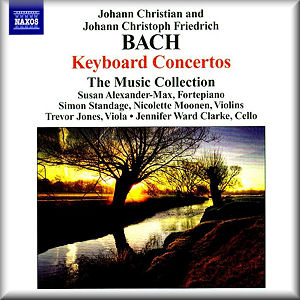 |
 |
|


alternatively
CD: MDT
AmazonUK
AmazonUS
Sound
Samples & Downloads |
Johann Christoph Friedrich BACH
(1732-1795)
Concerto for keyboard, strings and bass in A (Warb YC 91 / BR JCFB
C 30) [20:49]
Concerto for keyboard, strings and bass in E flat (Warb YC 90 /
BR JCFB C 29) [18:58]
Johann Christian BACH (1735-1782)
Concerto for keyboard, 2 violins and bass in D, op. 13,2 (Warb C
63) [17:18]
Concerto for keyboard, 2 violins and bass in B flat, op. 13,4 (Warb
C 65) [14:18]
 The Music Collection (Susan Alexander-Max (fortepiano), Simon Standage,
Nicolette Moonen (violin), Trevor Jones (viola), Jennifer Ward Clarke
(cello))
The Music Collection (Susan Alexander-Max (fortepiano), Simon Standage,
Nicolette Moonen (violin), Trevor Jones (viola), Jennifer Ward Clarke
(cello))
rec. 6-8 March 2007, Weston Parish Church, Weston, Hertfordshire,
UK. DDD
 NAXOS 8.570474 [71:38]
NAXOS 8.570474 [71:38] 
|
|
|
In the 18th century two important developments in the realm
of keyboard music took place. Firstly, the role of the keyboard
in music for instrumental ensemble changed. Traditionally it
was limited to playing the basso continuo. But during the first
half of the 18th century composers began to write music in which
the keyboard was given a concertante part. Johann Sebastian
Bach was one of the first to do so in his harpsichord concertos
and his sonatas for keyboard and violin. Secondly, the dominance
of the harpsichord was broken around the middle of the century
with the emergence of the fortepiano which had been developed
around 1700 by Bartolomeo Cristofori.
It wasn't until the 1770s that the fortepiano was fully accepted
as an alternative to the harpsichord. Most music for keyboard,
whether solo or as part of an instrumental ensemble, could be
played on harpsichord or fortepiano. That does not mean it doesn't
matter which instrument is chosen. It is an established fact
that Johann Christian Bach played the fortepiano in public concerts,
and that makes it plausible to choose this instrument to perform
the two concertos recorded here. They were written in the 1770s,
and when Bach played them the fortepiano still wasn't a common
instrument in England. In her liner notes Susan Alexander-Max
writes that when Bach was playing the fortepiano in public,
Muzio Clementi - who was to become a manufacturer of fortepianos
- was still playing the harpsichord.
These two concertos are written in the galant idiom for which
Johann Christian was famous. The melody is the most important
part of these compositions. And as Bach always had a good feeling
for what would go down well with his audience, the Concerto
in B flat ends with an 'allegro con moto' which is based
on the Scottish song 'The Yellow-haired Laddie'. It is notable
that these concertos are scored for keyboard, two violins and
cello, without a part for the viola. This strongly suggests
a performance with one instrument per part, a practice which
is followed here. The fortepiano isn't specified in the booklet.
It is a nice-sounding instrument, but a table piano had probably
been more appropriate, as the recording by David Owen Norris
and Sonnerie shows ("The
World's First Piano Concertos" - Avie AV0014).
The two other concertos on this disc were previously attributed
to Johann Christian Bach as well. But recent research has revealed
that they were written by his older brother Johann Christoph
Friedrich, generally known as the Bückeburger Bach. They
are quite different from Johann Christian's concertos. The scoring
includes a part for viola, and the whole texture suggests a
larger ensemble than one instrument per part. That doesn't mean
that this 'minimalistic' scoring is historically wrong, just
that a larger ensemble would give these concertos more impact.
The fortepiano used here is more appropriate in these concertos
than in Johann Christian's.
The two by Johann Christoph Friedrich are also different in
their idiom. The slow movements bear the traces of the Empfindsamkeit.
In both the strings play with mute, which was a very common
phenomenon in solo concertos and symphonies from the middle
of the 18th century. The fast movements have some of the nervousness
of the Sturm und Drang. In both concertos the keyboard
regularly plays drum basses, also a common feature of music
from the mid-18th century.
The performances give a good idea of the character and quality
of these keyboard concertos. Susan Alexander-Max plays with
panache and verve in the fast movements, and exposes the expression
in the slow movements quite well. The strings give good support
- and that is exactly what their role is. The keyboard is in
the centre of the proceedings, and that is reflected in the
recording.
This disc is recommendable not only for the quality of the music
but also for the performances. The oeuvre of these two sons
of Johann Sebastian Bach is still underestimated. This CD could
well serve to change that.
Johan van Veen
see also review by Tim
Perry
|
|

